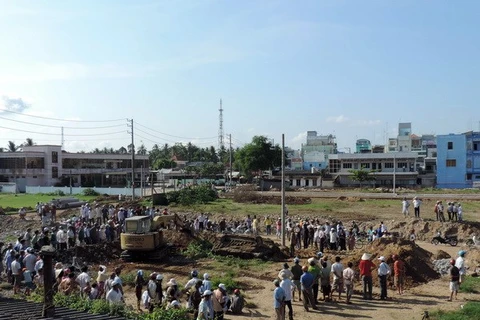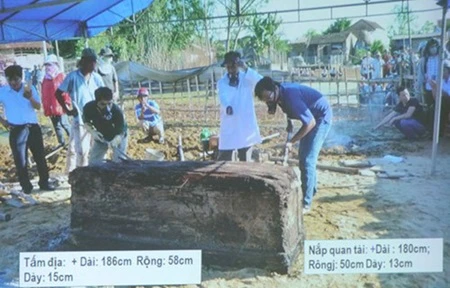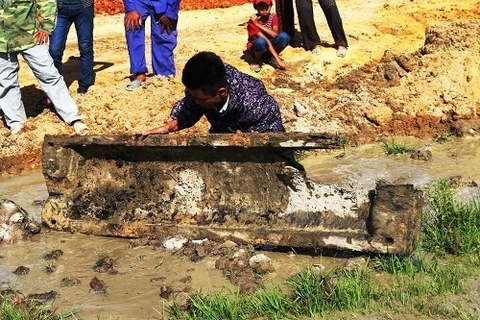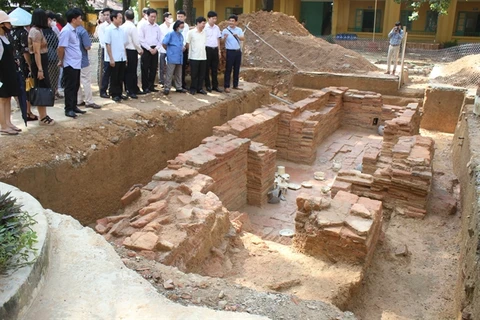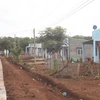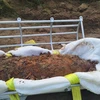Ha Tinh (VNS/VNA) - An ancient tomb dating back 1,400 years has been unearthed in a field in the central province of Ha Tinh's Nghi Xuan district, archaeologists have announced.
The arch-shaped tomb made of kilned bricks of different sizes was discovered at an irrigation construction site while workers were digging a canal through cultivation areas in Xuan Hong commune last week.
The discovery was immediately reported to the local heritage management unit.
Initial research showed the relic is an ancient Han tomb built during the Chinese Sui-Tang Dynasty more than 1,400 years ago.
The tomb was found 2m deep underground and measured 4m in length, 1m in width, and 1.2m in height.
The bricks that were used to build the tomb were in the form of a square box or grapefruit section usually used for building arch-shaped architectures.
The grave is located in the heart of a stream, on the flow of an irrigation canal which is under construction in Xuan Hong commune.
The construction works, unfortunately, have caused some damage to the dome revealing part of the tomb, most of which was buried under the soil.
Some locals in the commune said they had found similar tombs in their gardens or during the process of building houses.
Many others said the same type of Han graves had been found in other localities in Ha Tinh.
The discovery of the ancient tomb in Xuan Hong commune has created favourable conditions for archaeologists to study more about the Han tombs in Ha Tinh.
Earlier, experts found similar tombs in other localities in plain areas of Ha Tinh such as Duc Tho, Can Loc, and Nghi Xuan districts. The discovery provides archaeologists more foundation for researching ancient Vietnamese burial traditions.
In 1996, a boat-shaped tomb made from a tree trunk dating back to the 13th century was discovered at a construction site in a mountainous area in Ha Tinh.
The tomb was found at a depth of 3m in Ngan Truoi Hydroelectricity Plant, in Duc Dong commune, Duc Tho district.
That was the first time such a boat-shaped tomb was found in a mountainous area in the province. It showed ancient Vietnamese people resided in both flat areas and mountains in early times, archaeologists said./.
The arch-shaped tomb made of kilned bricks of different sizes was discovered at an irrigation construction site while workers were digging a canal through cultivation areas in Xuan Hong commune last week.
The discovery was immediately reported to the local heritage management unit.
Initial research showed the relic is an ancient Han tomb built during the Chinese Sui-Tang Dynasty more than 1,400 years ago.
The tomb was found 2m deep underground and measured 4m in length, 1m in width, and 1.2m in height.
The bricks that were used to build the tomb were in the form of a square box or grapefruit section usually used for building arch-shaped architectures.
The grave is located in the heart of a stream, on the flow of an irrigation canal which is under construction in Xuan Hong commune.
The construction works, unfortunately, have caused some damage to the dome revealing part of the tomb, most of which was buried under the soil.
Some locals in the commune said they had found similar tombs in their gardens or during the process of building houses.
Many others said the same type of Han graves had been found in other localities in Ha Tinh.
The discovery of the ancient tomb in Xuan Hong commune has created favourable conditions for archaeologists to study more about the Han tombs in Ha Tinh.
Earlier, experts found similar tombs in other localities in plain areas of Ha Tinh such as Duc Tho, Can Loc, and Nghi Xuan districts. The discovery provides archaeologists more foundation for researching ancient Vietnamese burial traditions.
In 1996, a boat-shaped tomb made from a tree trunk dating back to the 13th century was discovered at a construction site in a mountainous area in Ha Tinh.
The tomb was found at a depth of 3m in Ngan Truoi Hydroelectricity Plant, in Duc Dong commune, Duc Tho district.
That was the first time such a boat-shaped tomb was found in a mountainous area in the province. It showed ancient Vietnamese people resided in both flat areas and mountains in early times, archaeologists said./.
VNA

